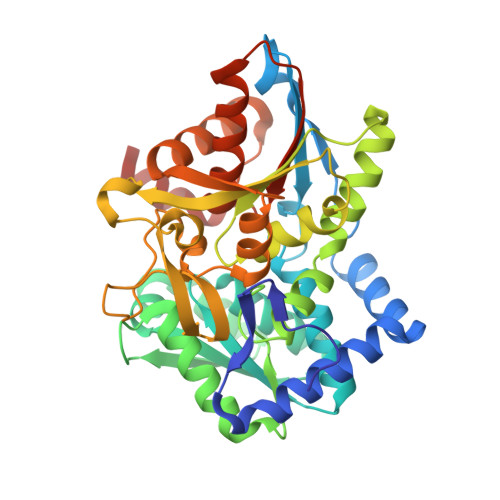On the Structural Basis of the Catalytic Mechanism and the Regulation of the Alpha Subunit of Tryptophan Synthase from Salmonella Typhimurium and Bx1 from Maize, Two Evolutionarily Related Enzymes.
Kulik, V., Hartmann, E., Weyand, M., Frey, M., Gierl, A., Niks, D., Dunn, M.F., Schlichting, I.(2005) J Mol Biology 352: 608
- PubMed: 16120446
- DOI: https://doi.org/10.1016/j.jmb.2005.07.014
- Primary Citation of Related Structures:
1RD5, 1TJP, 1TJR, 1WBJ - PubMed Abstract:
Indole is a reaction intermediate in at least two biosynthetic pathways in maize seedlings. In the primary metabolism, the alpha-subunit (TSA) of the bifunctional tryptophan synthase (TRPS) catalyzes the cleavage of indole 3-glycerol phosphate (IGP) to indole and d-glyceraldehyde 3-phosphate (G3P). Subsequently, indole diffuses through the connecting tunnel to the beta-active site where it is condensed with serine to form tryptophan and water. The maize enzyme, BX1, a homolog of TSA, also cleaves IGP to G3P and indole, and the indole is further converted to 2,4-dihydroxy-7-methoxy-2H-1,4-benzoxazin-3(4H)-one, a secondary plant metabolite. BX1 cleaves IGP significantly faster to G3P and indole than does TSA. In line with their different biological functions, these two evolutionary related enzymes differ significantly in their regulatory aspects while catalyzing the same chemistry. Here, the mechanism of IGP cleavage by TSA was analyzed using a novel transition state analogue generated in situ by reaction of 2-aminophenol and G3P. The crystal structure of the complex shows an sp3-hybridized atom corresponding to the C3 position of IGP. The catalytic alphaGlu49 rotates to interact with the sp3-hybridized atom and the 3' hydroxyl group suggesting that it serves both as proton donor and acceptor in the alpha-reaction. The second catalytic residue, alphaAsp60 interacts with the atom corresponding to the indolyl nitrogen, and the catalytically important loop alphaL6 is in the closed, high activity conformation. Comparison of the TSA and TSA-transition state analogue structures with the crystal structure of BX1 suggests that the faster catalytic rate of BX1 may be due to a stabilization of the active conformation: loop alphaL6 is closed and the catalytic glutamate is in the active conformation. The latter is caused by a substitution of the residues that stabilize the inactive conformation in TRPS.
- Max Planck Institut fur medizinische Forschung, Abteilung fur Biomolekulare Mechanismen, Jahnstr. 29, 69120 Heidelberg, Germany.
Organizational Affiliation:




















